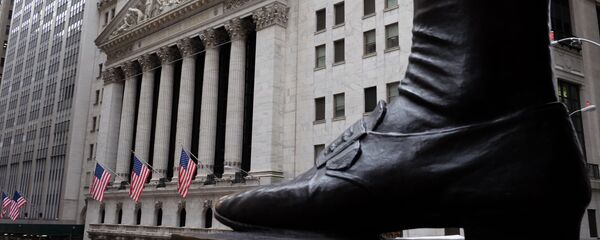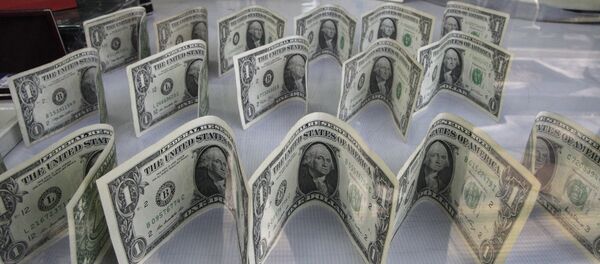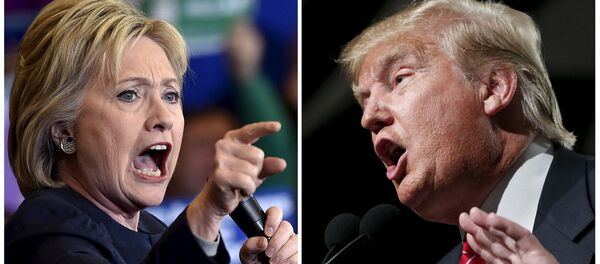Kristian Rouz — With the current US business cycle ending within the next year, the currently sluggish growth, rife international headwinds, declining corporate profits, lingering stickiness in wages and prices, and rising expectations of an economic downturn, a shift in economic policy might prevent an across-the-board contraction in the US GDP.
The upcoming presidential election is likely to determine the direction of further policy, with options predominantly limited to maintaining the status quo, or implementing elements of supply-side economics in the near-to-mid-term, with recession aversion being the pivot point on the new White House administration's agenda.
The decisive actions taken by @POTUS & policymakers helped us lay the foundation for a more sustainable path forward https://t.co/myqdbWZ4m5
— Treasury Department (@USTreasury) 21 June 2016
The chances of a recession starting in the US in late 2016-early 2017 have increased to 30-50 percent from the previously consensus-expected 20 percent after the UK opted out of the European Union, sending shockwaves across many of the world's economies, including the US. With yields on US Treasuries projected to decline further, driving gains in the dollar's FX rate, the US inflation rate might collapse back to near-zero as Brexit is poised to slow trade and investment on a global scale, adding to the already-prevalent tendency towards a deceleration in GDP gains in advanced economies and emerging markets alike.
"This is the end of globalization as we know it," Bill Gross of the Janus Global Unconstrained Bond Fund said.
What is wrong with Neo-Keynesianism?
Since the global financial meltdown of 2007-2009, the US economic authorities, primarily the Federal Reserve and the Department of the Treasury, have been reliant on a combination of monetary and fiscal policy measures in order to get the economy back on track. These include the provision of money liquidity on very loose terms, in full accordance with the Neo-Keynesian idea of economic policy.
Increased US government spending, in the meantime, has pushed a lot of private investment from the non-financial sector, contributing to the surge of the stock market to its historic highs in mid-2015, and its subsequent collapse in early 2016 following a rate hike last December.
Subsequently, the US economy has lacked a driving force which would allow it to expand further, as the abundance of money liquidity does not solve the structural issues, such as the discrepancy between gains in the financial and non-financial sectors, a contraction in domestic manufacturing, sluggish job creation, weak inflation and stagnation in effective wages and disposable incomes.
What can be done to fix the economy?
In order to spur economic growth, capital investment needs to be diverted into the non-financial sector, spurring the domestic production of goods and services, allowing for sustainable gains in the labour market and wages, pushing inflation up and accelerating domestic US consumption, driving over 70 percent of the nation's GDP. Certain elements of supply-side economics might come in handy in this process.
Tax Cuts
The theoretical formula knows as the Laffer curve suggests lower taxes actually boost the tax revenues of a government; this happened in the US and Ireland in the early 1980's. However, the "Bush tax cuts" contributed to the bubbles inflating in select sectors of the economy, meaning the policy measures should be applied prudently; even the greatest business cycle eventually comes to an end.
Protectionism
Many US-based manufacturers are unable to compete with cheaper imports when it comes to the consumer-oriented segment of goods production. Therefore, trade barriers and higher customs tariffs might boost domestic manufacturing, also pushing inflation up, contributed to faster GDP expansion. Yet, the downsides could include possible trade wars and poorer relations with US trading partners like mainland China and Mexico, while tariffs remain a constant reason for conflicts of interest between major players within the US. Until the early 20th century, tariffs comprised the lion's share of US budget income, and the heated debate surrounding the issue of lower/higher tariffs almost prompted South Carolina to secede from the US in 1832.
Labour market
Since the late 1970s, US inflation-adjusted wages have been nearly stagnant. Given the stunning rise of labour productivity in the US since then, the lingering stickiness in wages is a paradoxical issue. The currently low unemployment rates, below 5.0 percent, according to official figures, have generally failed to enhance disposable income rates during the past years, hampering inflation and overall GDP gains. While lower taxes and higher tariffs might contribute to the creation of market-competitive jobs (as opposed to the government-subsidized "full employment" of the past two years), the more important target is achieving sustainability in the labor market. Given that US labor participation rates are at their multi-decade lowest at just above 62 percent of the workforce, the heated minimum wage debate, and America's poorly-handled immigration system, the labor market will be one of the toughest challenges for the new administration to handle.
Higher interest rates
Should the economy gain momentum based on domestic manufacturing and consumption, raising the Federal Reserve's funds rates back to normality (above 2-3 percent) would be necessary in order to end the credit-fuelled growth model. That would only be possible, however, if inflation rates exceeded 5-6 percent, and growth rates remained in line with the core prices index: at least an annualized 3 percent.
All in all, the Neo-Keynesianism of the past eight years worked well until at least 2013, taking the economy back into the positive territory from the mire of the Great Recession, and providing a solid foundation for faster expansion down the road. However, the model started to falter amid mounting international headwinds, coupled with unfavorable developments domestically. The slide in corporate revenues that started in mid-2015 indicated the time to switch gears was slightly overdue, and it might not be until early 2017 that certain policy readjustments take effect.






